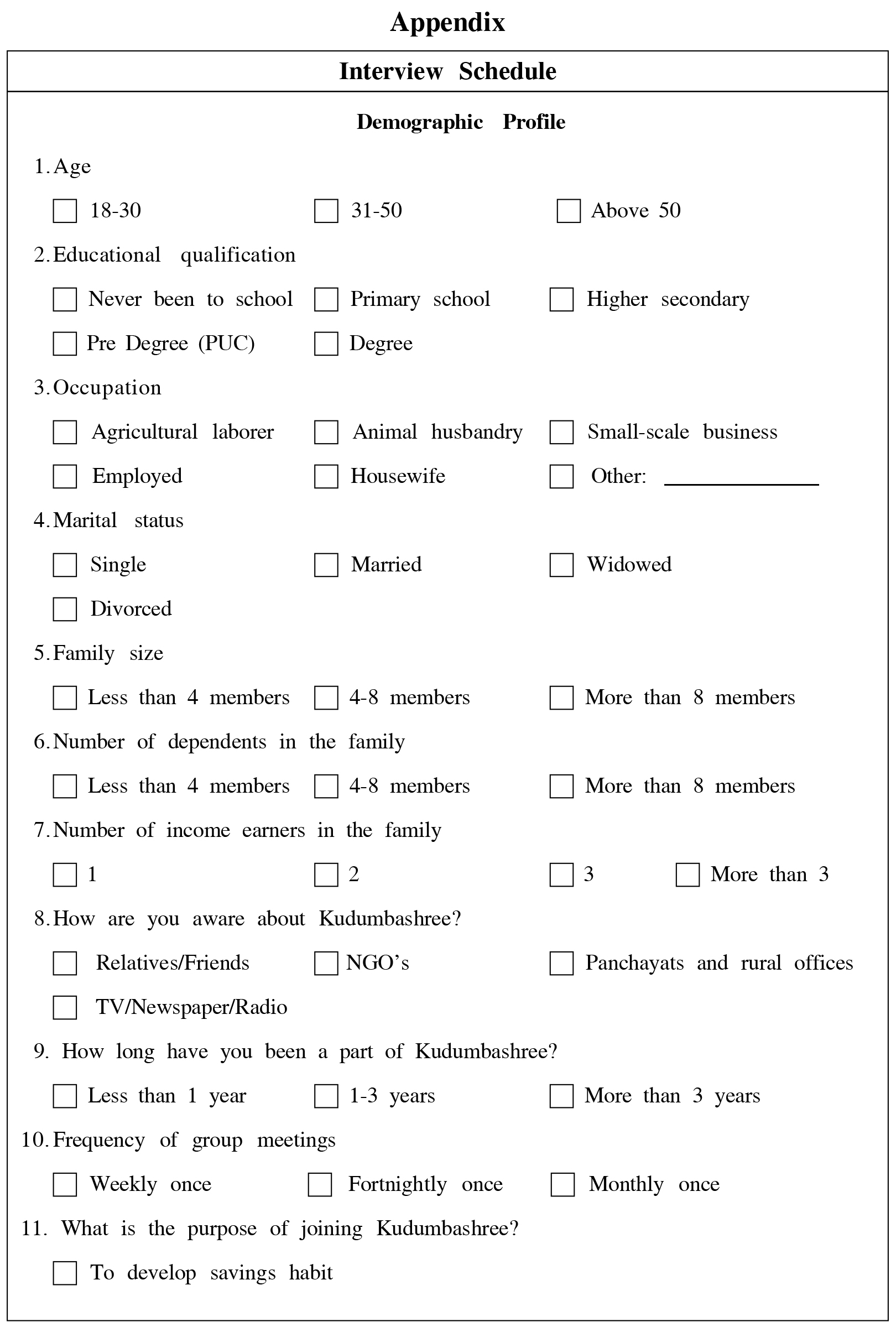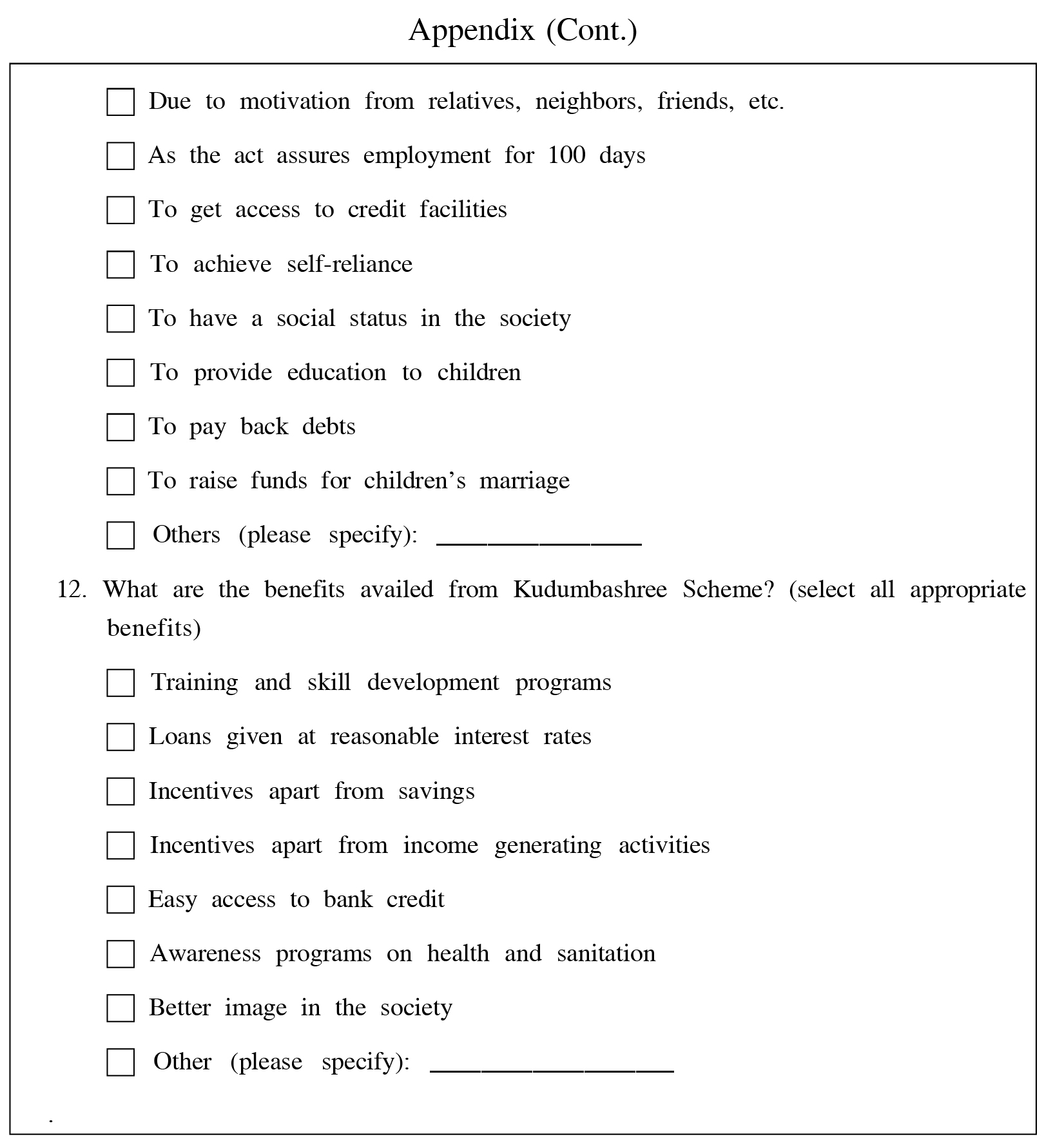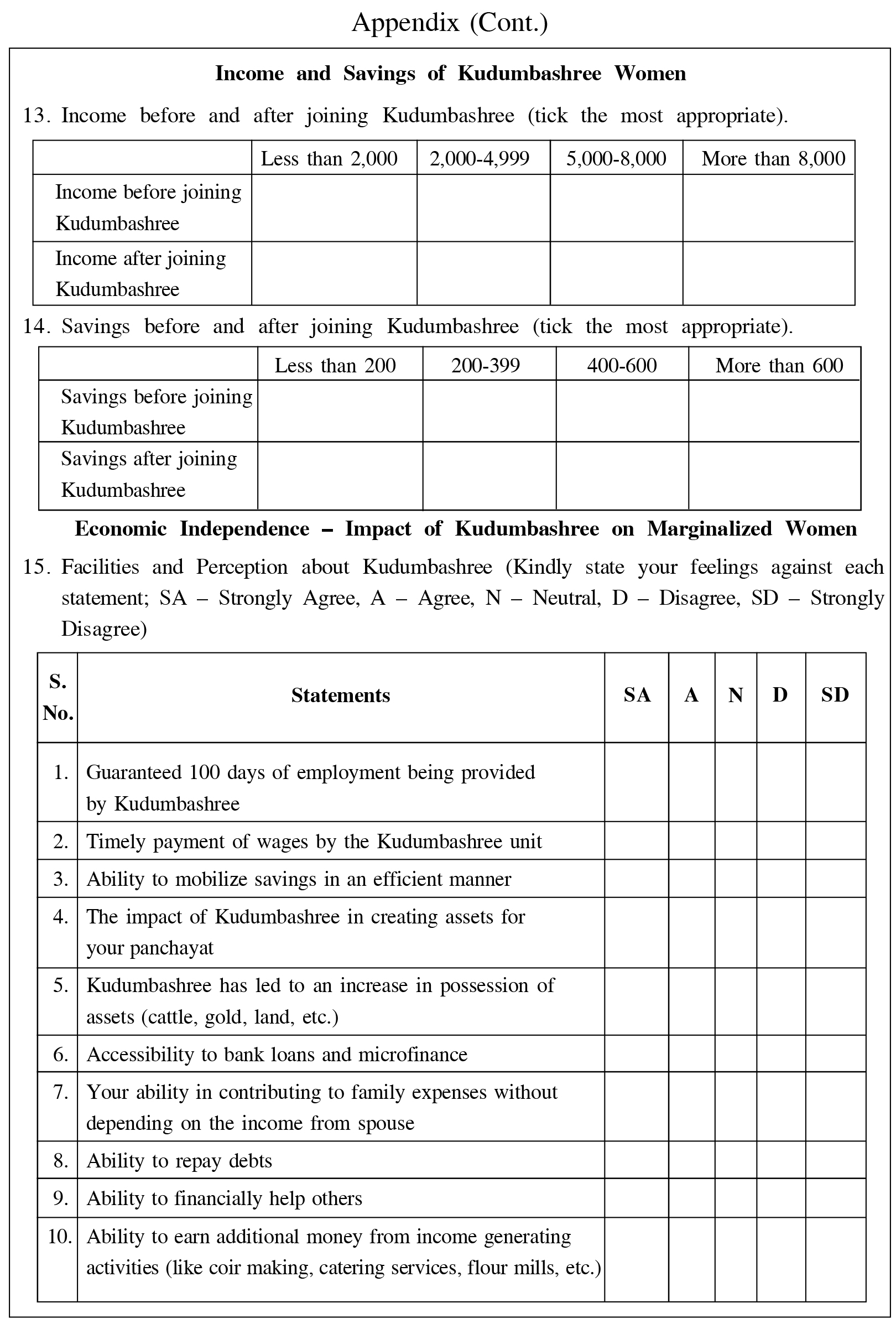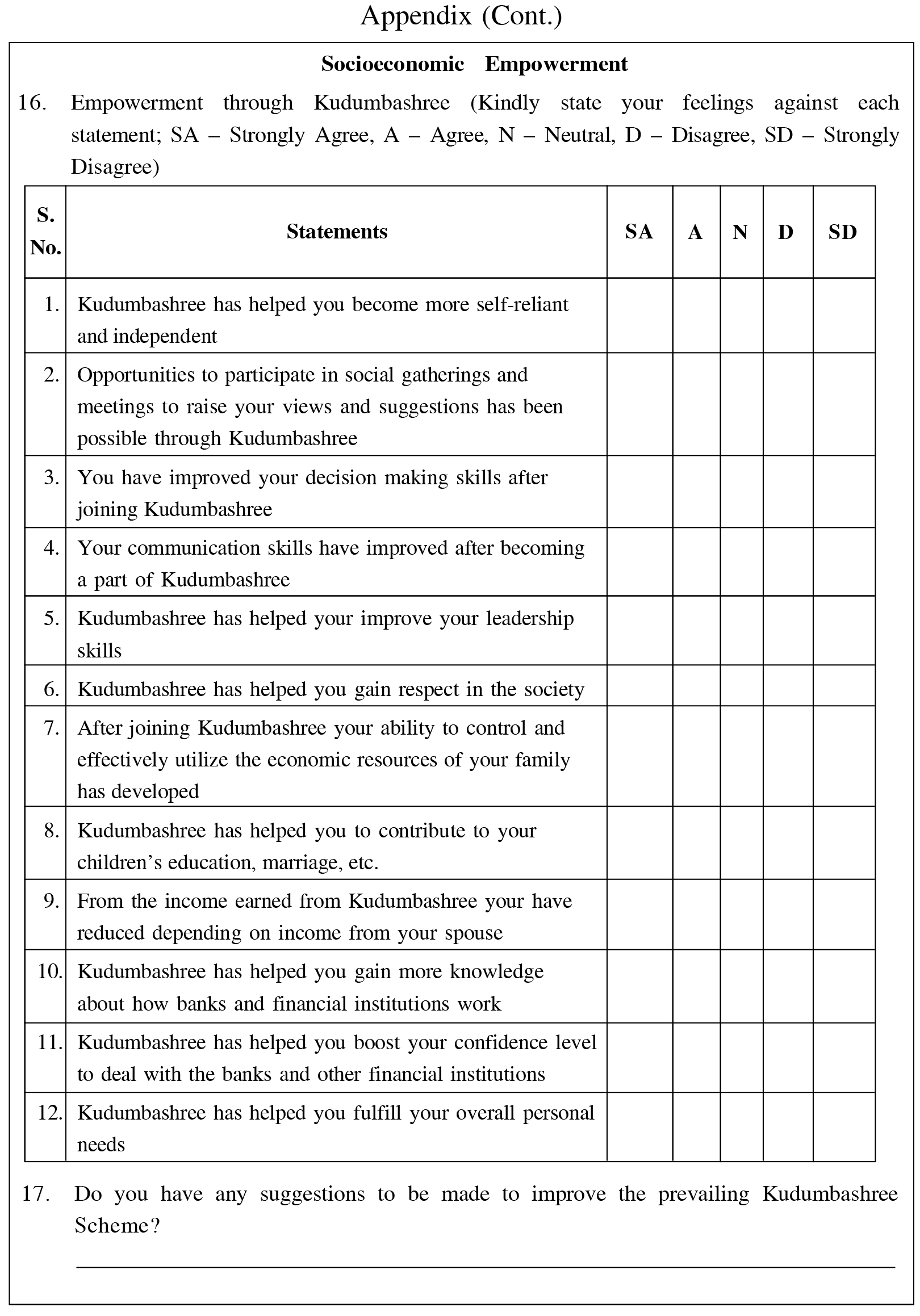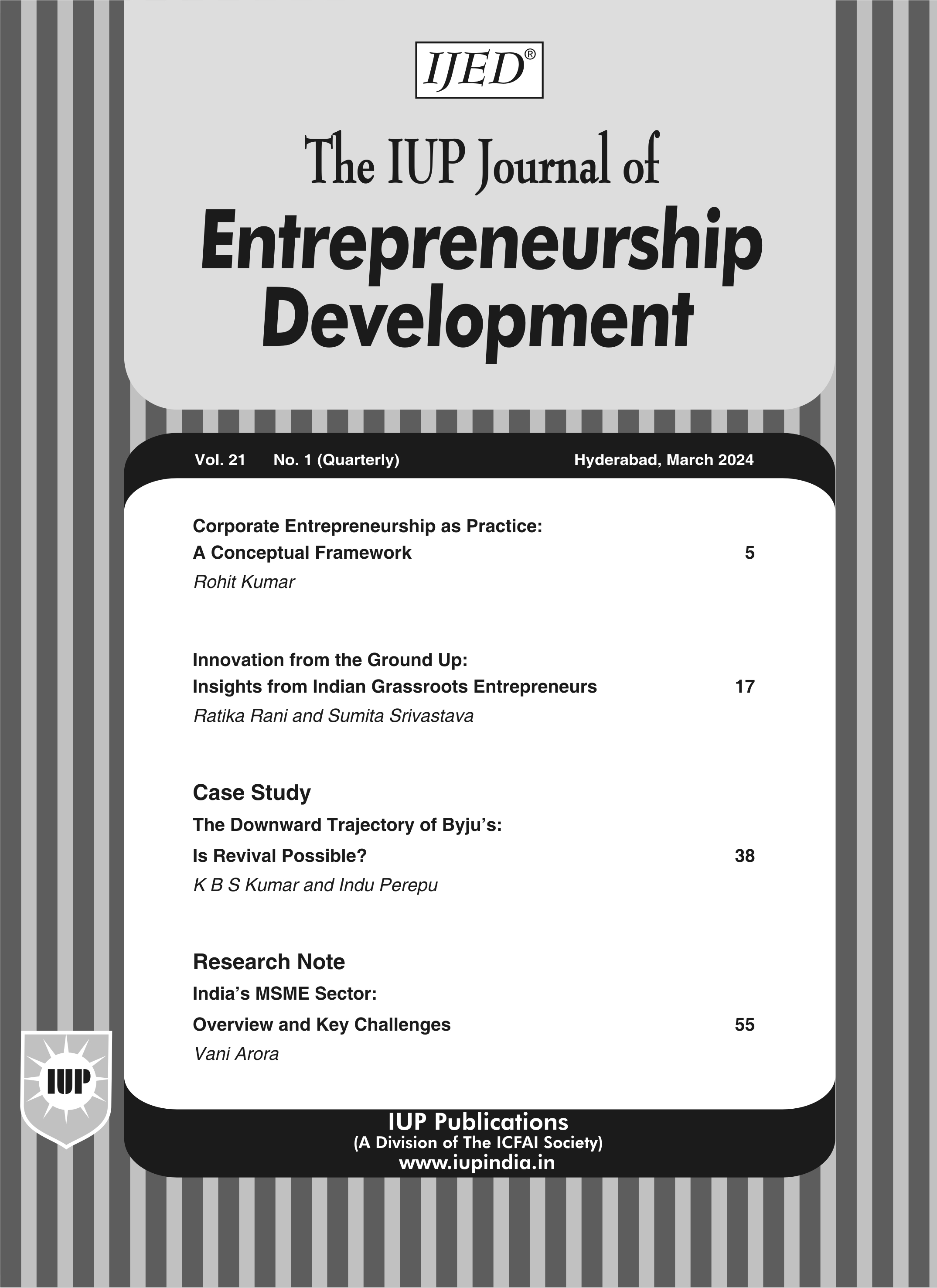
June'21
The IUP Journal of Entrepreneurship Development
Archives
The Impact of Kudumbashree Scheme on the Marginalized Women with Reference to Alappuzha District, Kerala
Poornima Vijaykumar
Assistant Professor, Department of Commerce & Management, St. Joseph's College of Commerce (Autonomous)
#163, Brigade Road, Bengaluru 560025, Karnataka, India; and is the corresponding author.
E-mail: poornima@sjcc.edu.in; ORCiD ID:https://orcid.org/0000-0003-4663-3885
Shradha Sangeeth
M.Com, Post Graduate Department of Commerce, St. Joseph's College of Commerce (Autonomous), Bangalore,
Karnataka, India. E-mail: shsangeeth08@gmail.com
Poverty, illiteracy, malnutrition, unemployment and negligence of marginalized women in the rural areas are one of the main constraints for India's development. In the recent times, there has been a changing trend in the contribution of women. In order to encourage and support their entrepreneurial skills, the Government of India (GoI) has taken various initiatives towards Self-Help Groups (SHGs) such as Kudumbashree Scheme and Stree Shakthi Scheme. Such schemes help women to increase their income and savings to attain self-reliance. The present study is a descriptive research to analyze the impact of Kudumbashree scheme on the women members in the district of Alappuzha, Kerala. The study found how marginalized women are empowered in the society through SHGs initiated by the Kudumbashree scheme. The primary data was collected from 384 women of 20,108 Neighborhood Groups (NHGs) in 12 blocks of Alappuzha district using an interview schedule, and the data was analyzed using SPSS and Microsoft Excel by performing one sample t-test and regression analysis. The respondents of the study agree that various dimensions of the Kudumbashree scheme have helped them achieve economic independence and socioeconomic empowerment, and in the upliftment of their wellbeing. Kudumbashree has improved the income and savings habit of women by making it compulsory for members to save and encourage reinvestment of money in various entrepreneurial activities. The study also observed that women were more self-reliant and confident after being part of Kudumbashree scheme.
Introduction
In ancient times, the status of women was undermined either by law or custom for decisionmaking,
personal and social rights. The subordination of women in the society is however a
mere extension of their subordination in the family. In a patriarchal society, the abstract idea
of justice and equality of women is not of much importance. Self-Help Groups (SHGs) have similar identity, heritage, and traditional occupation and manage resources efficiently for the
benefit of the group members. The rural marginalized women volunteered themselves to
organize into a group for eradication of poverty among its members. They save on a regular
basis and agree to convert their savings into a common fund along with funds from banks
and other financial institutions for meeting emergency requirements of its members. Therefore,
apart from the common fund generated out of small savings of the members, these internal
savings are supplemented by external resources, loaned or donated by agencies. Kudumbashree
is the poverty eradication and women empowerment program implemented by the State
Poverty Eradication Mission (SPEM) of the Government of Kerala. The name Kudumbashree
in Malayalam means 'prosperity of the family'. What is commonly referred to as
'Kudumbashree' could mean either the Kudumbashree Community Network, or the
Kudumbashree Mission, or both.
Kudumbashree was set up in 1997 following the recommendations of a three-member Task
Force appointed by the Kerala government. Its formation was in the context of the devolution
of powers to the Panchayati Raj Institutions (PRIs) in Kerala, and the Peoples' Plan Campaign,
which attempted to draw up the Ninth Plan of the local governments from below through the
PRIs.
The Kudumbashree scheme is a community network that covers the entire state of Kerala
consisting of a three-tier structure with Neighborhood Groups (NHGs) as primary level units,
Area Development Societies (ADS) at the ward level and Community Development Society
(CDS) at the local government level. Though poverty eradication and women empowerment
are the central themes of this community network, its main features include democratic
leadership and support structures formed from the 'Kudumbashree Family.'
Statement of the Problem
Over the past few decades, India is one among the developing countries which still face the
problem of women unemployment and poverty. Although the Government of India (GoI) is
launching various poverty alleviating, microfinance schemes and programs, people
benefitting out of these schemes are very less. The key problems addressed by the authors in
the study is the extent of outreach of Kudumbashree scheme, the level of involvement of
backward women which results in economic independence and the key factors determining
the socioeconomic empowerment of marginalized women. Apart from this, the impact of
microfinance on the poor in terms of household income, savings, asset creation, and
expenditure is also considered in the study.
Literature Review
Rajendran and Raya (2012) discussed how microfinance has improved the awareness on
children's education, health and hygiene and how it has helped in empowering the
respondent's self-confidence, courage and improved skills. Capacity building is the relevant
phenomenon mentioned in this study, which implies, strengthening the ability to undertake
economic, political and social activities and thereby enhance self-confidence, self-worth,
self-esteem and self-respect. In this study, capacity building is used as a criterion which helps in the transition of women's decision-making skills from marginality to centrality. In order to
assess capacity building, 15 variables were selected to elicit opinions of the respondents, out
of which eleven variables were used to assess improvements in knowledge and awareness in
aspects like health, education, role of NGOs and environmental protection. Simple statistical
tools like average and percentage analysis were used to draw conclusions. It was concluded
that microfinance had contributed to the improved awareness on children's education, health
and hygiene. It was also concluded that the respondents gained self-confidence, courage and
skill upgradation. However, microfinance could not contribute to improvement of knowledge
and awareness on government welfare schemes and marketing of products and subsidies from
DRDA. Hence, it was concluded that NGOs and bankers must take initiatives and effective
action in improving awareness in this regard.
Pokhriyal et al. (2014) understood how empowerment of women is an important issue in
developing countries and thus attempted to study the role of microfinance intervention in the
promotion of women empowerment with special reference to rural India. They studied the
application of various microfinance tools and its progress with the help of data provided by
the government and other institutions. The study suggested that education facilities and
family protection must be provided by Microfinance Institutions (MFIs) to strengthen and
expand a support system to the poor women.
George (2014) has reviewed and explained the major themes of certain selected studies.
The study was subdivided into heads, namely, empowerment: conceptual analysis, micro
finance at a glance and impact of micro finance on women empowerment. The researcher
explained that mechanisms which aim to improve the developing standards of the poor,
especially women, must be based on the ability to overcome the causes of their lack of
power. The researcher has adopted an empirical research literature and established that a
majority of the studies dealt either with the role or the impact of government organizations,
NGOs and SHGs in empowering women through micro financing. While some researches
consider this as a revolutionary criterion for development, others argue about the reality of
microcredits. However, more than half of the works reflect a positive impact of micro credit
on rural women.
Modi et al. (2014) conducted a study to gather insights regarding the extent to which
certain factors empower the rural women through microfinance services. The researchers used
descriptive statistics like simple percentage analysis and frequency, reliability statistics,
regression analysis and correlation analysis to analyze five main variables, i.e., women
empowerment through micro finance, socioeconomic status upgradation, autonomy for life
choices, women's position in the family/society, financial freedom and positive approach
towards child development. The study indicated that four out of five variables/factors
mentioned above had an effective impact on uplifting rural women. The results of the study
indicated that as the rural women started to earn more income, they were able to contribute
to their family expenses which resulted in economic independence and higher living
standards. The study also recommended that MFIs should try and extend more credit facilities
and government should grant tax exemptions and other incentives.
Janaki (2014) in the study explained that women empowerment is composed of a wide
range of interpretations right from considering it as a source from which individuals and
groups take their control of the situation and achieve their own goals to face the challenges
and existing power relations that involve gender discrimination. To study the same, 372
respondents out of 11,500 SHGs from Ranga Reddy district of Telangana were selected. Six
domains of empowerment were chosen for the study, i.e., Empowerment from within
(cognitive), Economic empowerment, Empowerment within family, Empowerment in public,
Political empowerment and Collective empowerment. Each of the domains had separate set
of impact variables which were put to test. The data was analyzed using percentage analysis
for demographic profiles and variables whereas chi-square test was performed for statistical
significance. The study revealed that loan utilization pattern differentially impacts the various
domains put to test. Another important observation was that micro entrepreneurs are given
more value within family and in public life and they enjoy more consideration when it comes
to monetary decision making. It was thus concluded that even though there is a positive
impact of microcredit on women empowerment, the benefit of monetary support is nominal
and limited to only few economic benefits.
Basu (2004) in a study explained how a woman's tendency to invest in safer investment
projects can be linked to a woman's desire to raise her bargaining position in the house.
The dimensions used to measure women's empowerment are economic, sociocultural,
familial/interpersonal, legal, political, and psychological. The empirical findings of the
study highlighted that women empowerment is established as a weak form. Basu's paper
included a very important policy implication which is appropriate to emphasize the strategy
of financial inclusion in a broader context of financial and economic growth. His study
showcases a clear picture of women entrepreneur's contribution towards the Indian
economy.
Objective
- One of the main objectives of this study is to assess the economic independence achieved by women through Kudumbashree scheme. This objective focuses on whether Kudumbashree women are able to support their families financially to meet unexpected expenses and most importantly whether they are able to make bold monetary decisions in the family.
- The next main objective is to analyze the socioeconomic empowerment of women through Kudumbashree scheme. An empowered woman is a self-confident woman who has the ability to critically analyze her environment and exercise proper decision making. This helps women to evaluate their problems in a different perspective and recognize their strengths. For this, they require a set of assets and capabilities at an individual and collective level. This objective thus focuses on whether women are able to acquire the capabilities collectively through Kudumbashree scheme in order to organize, mobilize and take actions to solve their problems.
Data and Methodology
The study is descriptive in nature based on both quantitative and qualitative data, which
mainly uses primary data, further supported by using secondary data. Primary data was
collected from sample Kudumbashree members of Alappuzha district, Kerala through an
interview schedule (see Appendix) specially designed for the study. Secondary data was
collected from published books, documents, journals, the Internet, and the official websites
of Kudumbashree, National Rural Employment Guarantee Scheme (NREGS) and other
published online and offline resources were extensively used for gathering data. The target
population is the entire Kudumbashree women registered under the scheme in the district of
Alappuzha, Kerala which accounted for 323,977 marginalized women among which a sample
of 384 women have been considered using an online sample size calculator with 5% margin
of error at 95% confidence interval. The authors have adopted a multi-stage probability
sampling technique as described in Table 1.
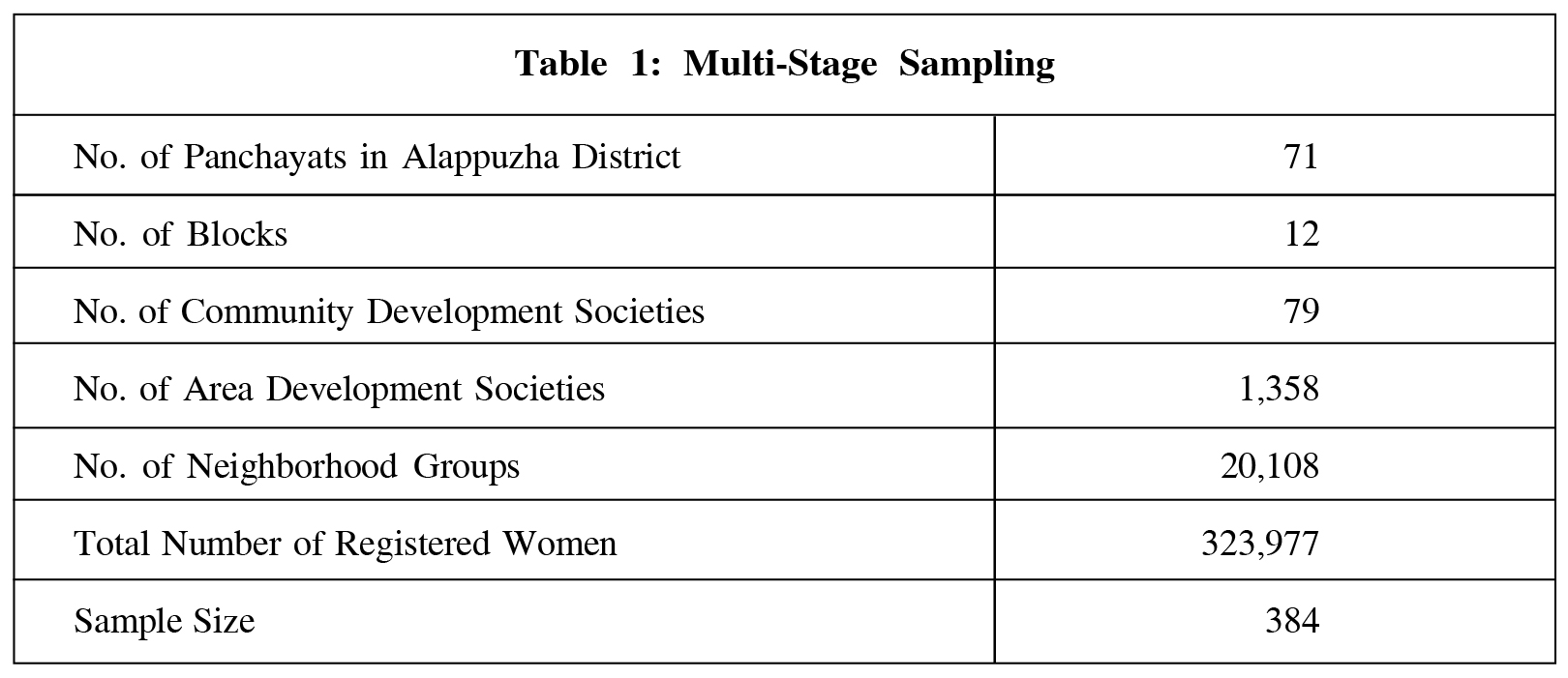
Results and Discussion
This section presents objective-wise analysis to better understand and address the key issues
of the study.
Descriptive Statistics of Economic Independence Through Kudumbashree
Scheme
In order to study the extent of economic independence through Kudumbashree scheme, 10
dimensions were considered and put to a simple mean and standard deviation analysis.
Table 2 summarizes the descriptive statistics of the 10 dimensions of economic independence
variables where the mean values indicate the agreement levels and the standard deviations
indicate similarity of opinions. It was found that a majority of the women agreed that they
were able to mobilize savings in an efficient manner and most importantly with the help of
Kudumbashree they were now able to access bank facilities and microfinance. All the women
responded honestly that they neither knew how to fill out a form nor how the banks
functioned. Nevertheless, Kudumbashree provided them the solution for it, since Kudumbashree
scheme makes it mandatory for all its members to have bank accounts which helped them overcome their fear of bank transactions. Another important finding was that women were able
to earn additional income from Kudumbashree's income-generating activities like food
processing, catering, coir making and flour mills.
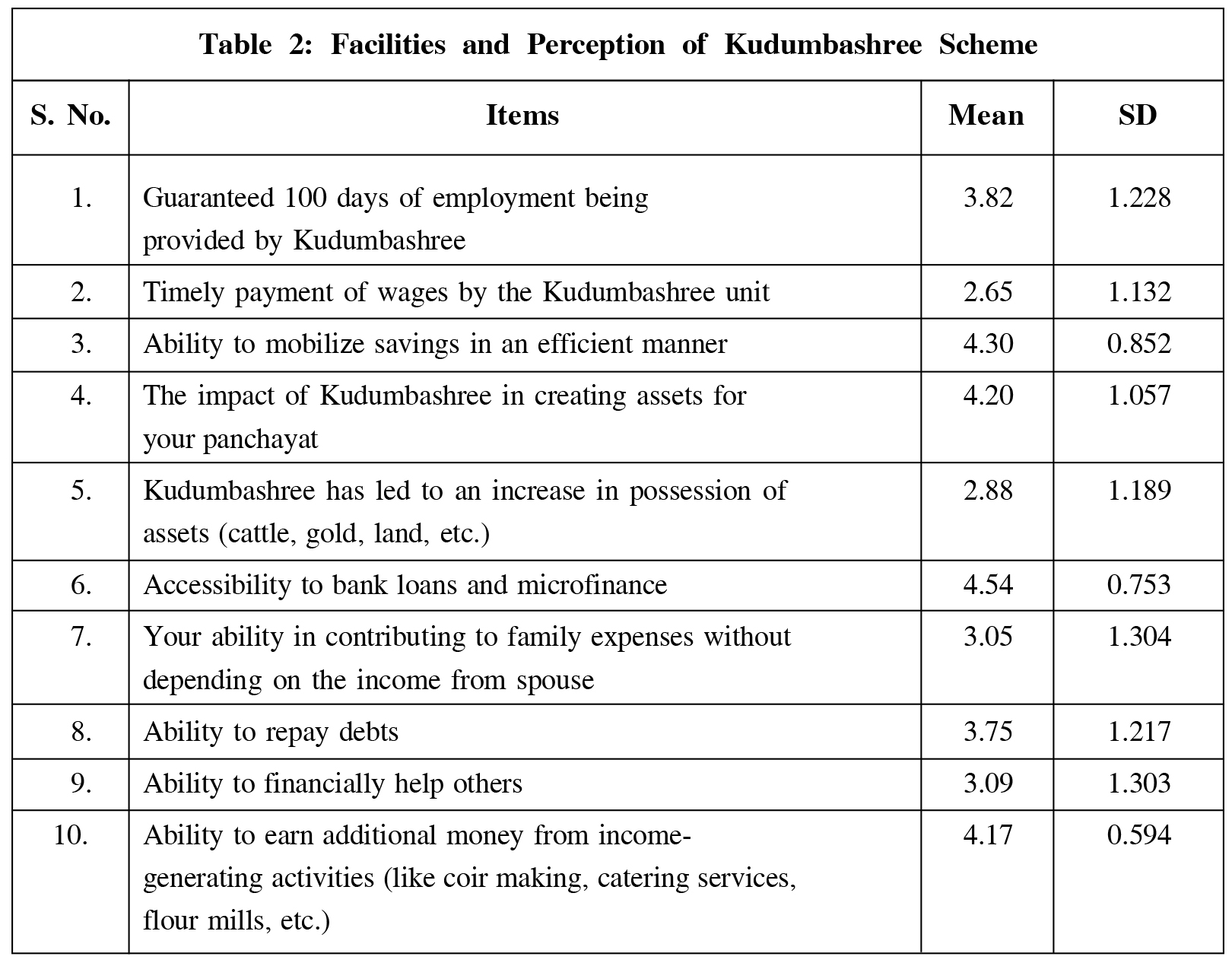
Descriptive Statistics of Socioeconomic Empowerment Through
Kudumbashree Scheme
Table 3 summarizes the descriptive statistics of 12 dimensions of socioeconomic
empowerment through Kudumbashree scheme. These 12 dimensions were put to simple mean
and standard deviation analysis where the mean values indicate the agreement levels and the
standard deviations indicate similarity of opinions. The women highly agreed that
Kudumbashree helped them to contribute to their children's education and marriage and also
made them very confident to approach the banks and financial institutions unlike earlier.
Another most important dimension that the respondents agreed to in general is that
Kudumbashree helped them achieve their overall personal needs. Through Kudumbashree
women were able to exploit more opportunities and through Kudumbashree which ultimately
enabled them to make improvements economically, socially and politically. All beneficiaries
agreed that they were now able to be more active and responsive in their own ways.
Economic Independence Achieved Through Kudumbashree Scheme
One of the main reasons why women joined Kudumbashree is because they can gain economic
independence through the activities conducted in this scheme. In order to study whether
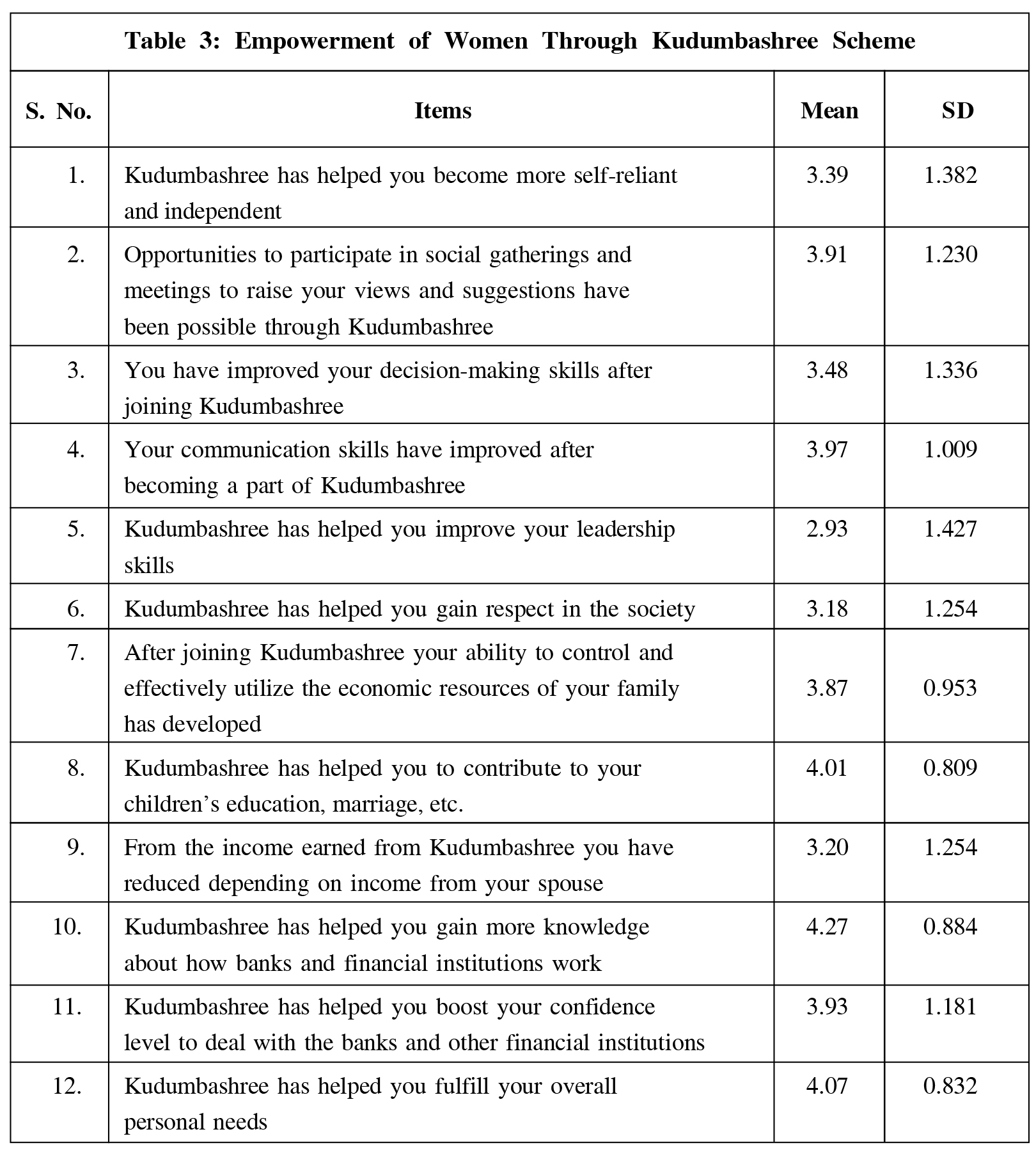
women have achieved economic independence through Kudumbashree or not, the authors
have framed the following hypothesis and tests using one sample t-test.
H01: There is no significant difference in economic independence achieved through
Kudumbashree scheme.
H11: There is significant difference in economic independence achieved through
Kudumbashree scheme.
Table 4 summarizes the one sample t-test statistics for economic independence, i.e., the
basic information of the selected variable using the number of observations, sample mean and
sample standard deviation as given below:

Table 5 displays the results most relevant to the one sample t-test. The test statistics is denoted by t and is calculated by dividing the mean difference by the standard error mean (from Table 4). The df or the degree of freedom for a one sample t-test is the population less than one (384 - 1 = 383). The mean difference is the difference between the observed mean sample (Table 4) and the expected mean, i.e., the test value. The confidence interval for this study is 95%.
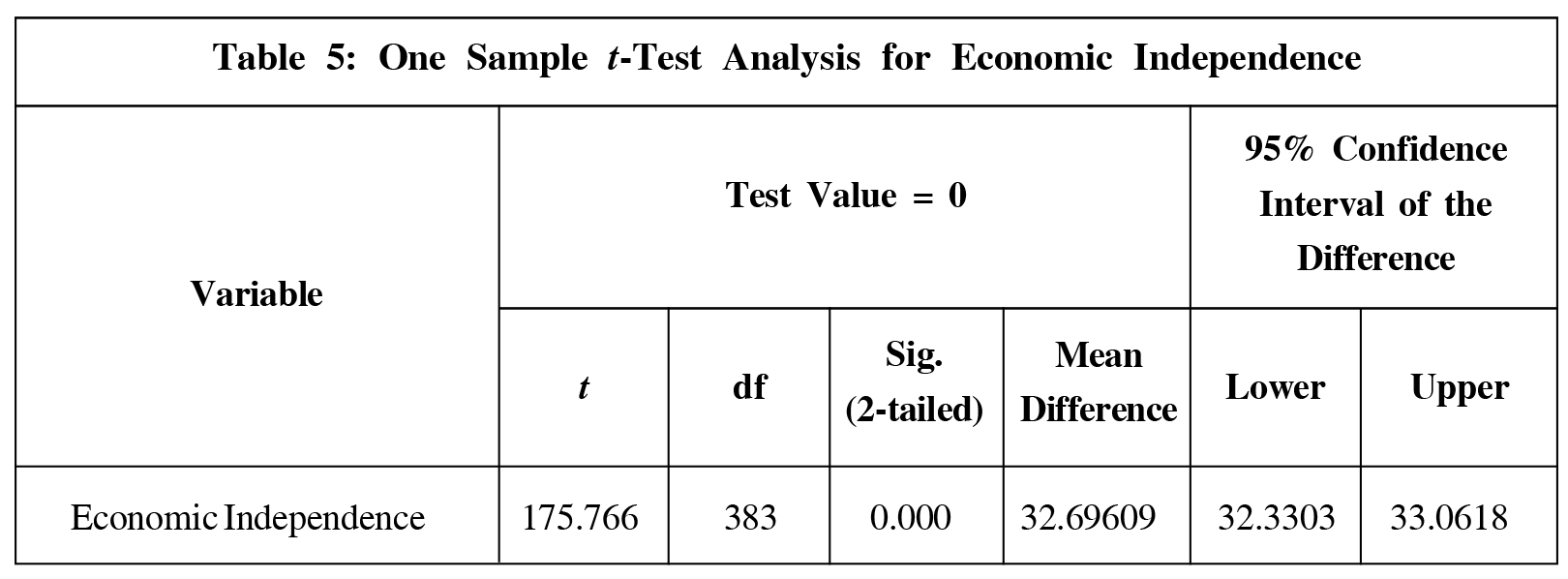
The result of one sample t-test output gives the t-statistics of 175.766 with 383 degrees of
freedom. The p-value here is 0.000 for the two-tailed test. Since the p-value obtained is less
than 0.05, the null hypothesis H01is rejected. It can be thus concluded that there is a
significant difference in economic independence achieved through Kudumbashree scheme at
5% level of significance.
By achieving economic independence, it implies that women are receiving timely wages
from 100 days of guaranteed work and they are able to mobilize their income efficiently. The
beneficiaries have also been able to increase the worth of their current asset holdings. Women
are now able to contribute to their family expenses along with the male counterparts which
makes them feel more confident and self-reliant.
Socioeconomic Empowerment Achieved Through Kudumbashree Scheme
The authors analyze the socioeconomic empowerment of women through Kudumbashree
scheme. The following hypothesis is framed and put to test using one sample t-test.
H02: There is no significant difference in the socioeconomic empowerment achieved
through Kudumbashree scheme.
H12: There is significant difference in the socioeconomic empowerment achieved
through Kudumbashree scheme
Table 6 summarizes the one sample t-test statistics for socioeconomic empowerment
through Kudumbashree scheme, i.e., the basic information of the selected variable using the
number of observations, sample mean and sample standard deviation.

Table 7 displays the results most relevant to the one sample t-test. The result of one sample t-test output gives the t-statistics of 126.577 with 383 degrees of freedom. The p-value for the two-tailed test is 0.000. Since, the p-value obtained is less than 0.05, the null hypothesis H02 is rejected. It can be thus concluded that there is a significant difference in socioeconomic empowerment achieved through Kudumbashree scheme at 5% level of significance.
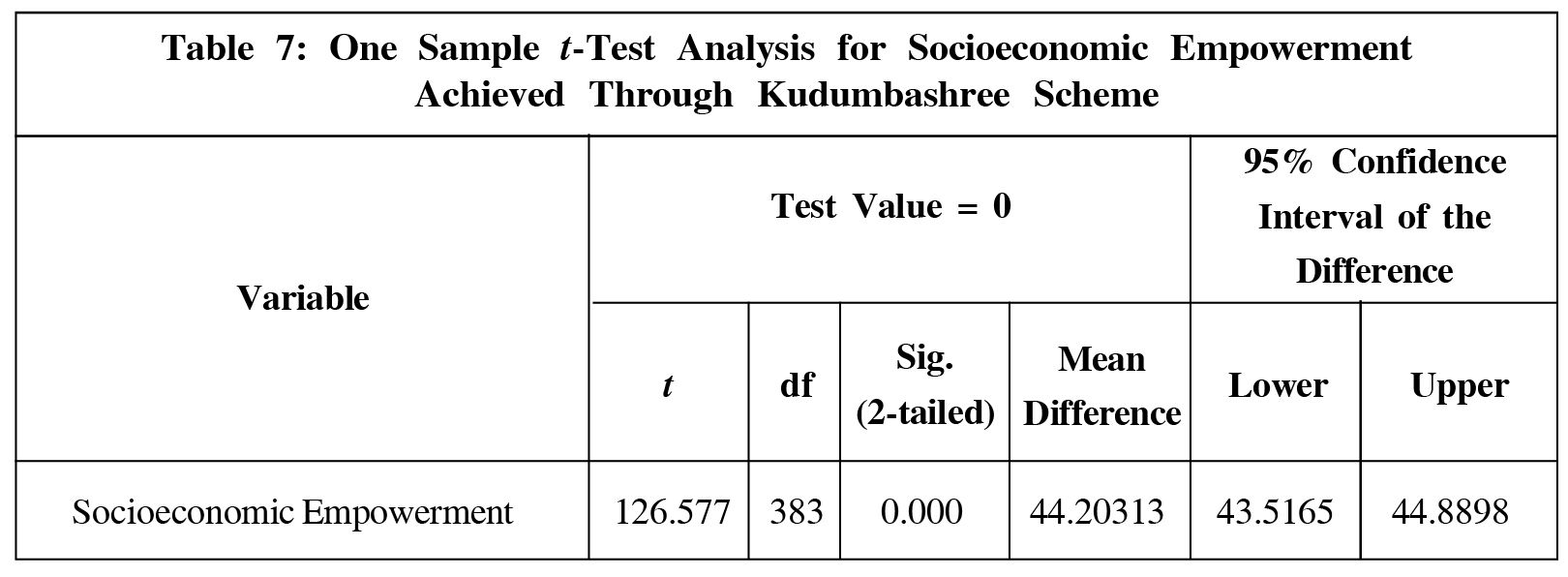
Self-reliance, skill development and knowledge acquisition have helped women achieve
socioeconomic independence which in turn resulted in empowerment. Women felt more
independent as they got various opportunities to participate in social gatherings and meetings
to raise their views and suggestions. This also helped them to develop their communication,
leadership and decision-making skills.
Impact of Economic Independence on Socioeconomic Empowerment
This part of the study verifies the degree of impact of socioeconomic empowerment over
economic independence. Therefore, the main purpose of this study is justified through the
following hypothesis using regression analysis.
H03: Economic independence has no impact on socioeconomic empowerment of
women.
H13: Economic independence has an impact on socioeconomic empowerment of
women.
Regression Analysis
Table 8 shows a relationship between a dependent variable (socioeconomic empowerment)
and an independent variable (economic independence). This table is a model summary which
reports the strength of the relationship between the variables.

The model summary provides the R and R2 values. The R-value provides the simple
correlation which in this case is 0.873 (the "R" column) which indicates a high degree of
correlation between socioeconomic empowerment (dependent variable) and economic
independence (independent variable). The R2 (the "R2" column) value of 0.762 indicates a
very high percent of variance in the dependent variable explained by the independent
variable.
ANOVA Results
Table 9 displays the ANOVA table which explains how well the regression equations predict
the dependent variable.
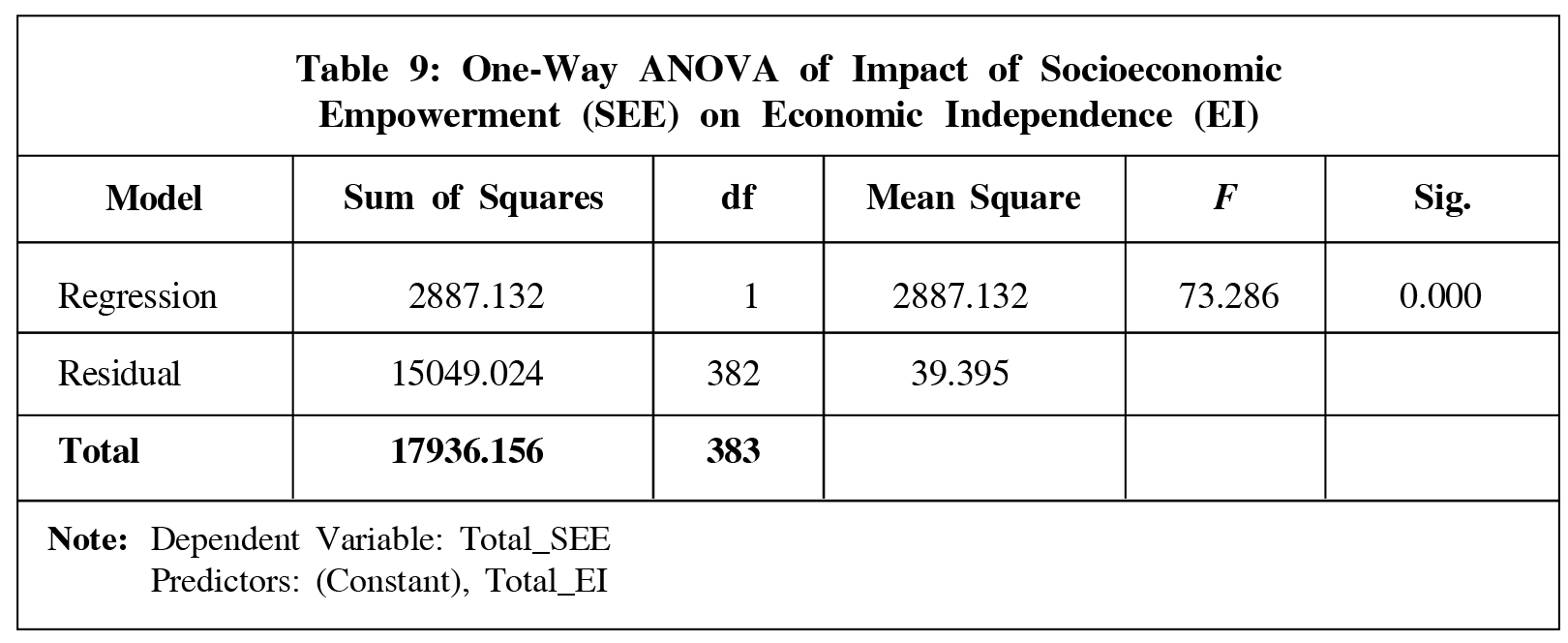
The ANOVA table reports how well the regression equation fits the data. The results of
ANOVA table with df, F and Sig. tests the significance of the model. The p-value 0.000
indicates that the regression model is statistically significant. Since p-value is less than 0.05,
null hypothesis H01 is rejected.
Table 10 is the coefficient table provides necessary information which helps to
conclude the extent of the impact of economic independence on socioeconomic
empowerment.
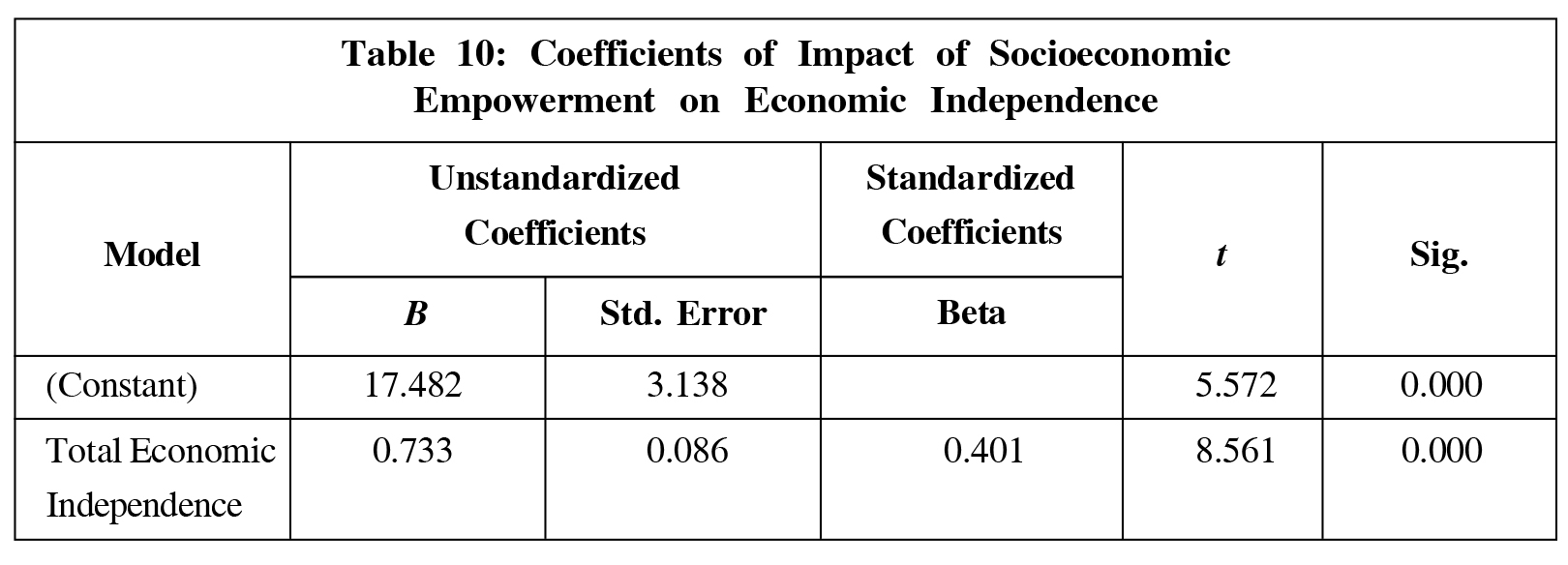
The coefficient table values help to construct the regression equation. The unstandardized
coefficients B is the intercept (or constant) a = 17.482 (socioeconomic empowerment) and the
slope of the line, b = 0.733 (economic independence).
On the basis of the collected responses from marginalized women, an attempt is made to
analyze the socioeconomic empowerment. For this purpose, economic independence was
taken as the independent variable and socioeconomic empowerment as the dependent
variable. Table 10 indicates that the calculated p-value 0.000 is less than the standard p-value
of 0.05 which makes it clear that the null hypothesis H01 is rejected. Hence, it proves that
economic independence has an impact on socioeconomic empowerment of women. Women
have stated that they achieved economic empowerment through the guaranteed 100 days of
employment and the timely wages provided by Kudumbashree which helped them to improve
the ability to control and effectively utilize the economic resources and also to contribute to
the family expenses and become self-reliant without depending on their spouses for the
income and daily expenses.
Major Findings
- The one sample t-test analysis revealed that there is a significant difference in economic independence achieved through Kudumbashree scheme. Economic independence of marginalized women of Kudumbashree has been achieved through various factors in which majority of the women stated that Kudumbashree has helped them develop the ability to mobilize savings in an efficient manner and get more accessibility to banking services. Kudumbashree has also helped in creating various assets in the villages and thus women also earned additional income from other income-generating activities within Kudumbashree.
- Socioeconomic empowerment: One sample t-test analysis revealed that there is a significant difference in socioeconomic empowerment achieved through Kudumbashree scheme. Women developed socioeconomic empowerment through Kudumbashree scheme. Women were able to participate more in the banking transactions as Kudumbashree made it mandatory to have bank accounts. Through various skill development activities undertaken by the scheme, women could develop their communication skills. Women could also contribute to the family expenses; children's marriage and their education which made them feel more selfreliant and confident. Thus, it was found that women were able to achieve their overall personal needs by becoming a part of the Kudumbashree scheme.
- The two variables 'economic independence' and 'socioeconomic empowerment' were used for simple linear regression analysis and revealed that Economic Independence has an impact on socioeconomic empowerment of women in the Kudumbashree scheme.
Suggestions
- Women had responded during the interview schedule that the panchayat is taking advantage of the illiteracy of marginalized women and were collecting fee to issue job cards which is supposed to be issued free of cost. Hence, it is strongly suggested that the panchayat officials should rightly consider the beneficiaries.
- Women also suggested that interest rates should be lowered as they wish to save more rather than paying the dues of the loan.
- The members in Kudumbashree have considerable innovative income-generating ideas which are not taken into consideration due to lack of systematic follow-ups from the concerned authorities.
Conclusion
Kudumbashree works on the assumption that group formation is crucial for facilitating the
process of empowerment as women draw strength and courage when they are in a group
atmosphere. Women were able to actively and regularly involve in the activities of
Kudumbashree scheme which enabled them to experience a different lifestyle where they
get a platform and a space for sharing and expressing their concerns. The Kudumbashree
women started to reanalyze their lives and look into their problems from a different
perspective. They were able to recognize their potential and enhance their self-image in the
society, acquire new skills and respond positively towards the given environment. This
proves that an initial step towards an overall empowerment has been already started through
Kudumbashree scheme.
The study observed that the respondents have seen an improvement in their standard of
living after joining Kudumbashree scheme. A majority of the respondents have become more
confident and self-reliant which leads them to have a better standard of living. Women are
now less dependent on the income earned by the male counterparts and are now able to meet
their family expenses and increase their possession of assets. Women now have more access
to banks and financial institutions and have improved their confidence to communicate with
officials. Women have also gained control over the economic resources of the family. This
shows that the predominant objectives of implementing Kudumbashree scheme in Kerala have
been achieved, which reveals that the Kudumbashree scheme has been able to empower
marginalized women of Alappuzha district.
Future Scope: The scope of the present study was to find out the effectiveness of Kudumbashree
scheme measured through economic independence and socioeconomic empowerment constructs.
Kudumbashree scheme has made women an integral part of economic development and as per
the present study it is functioning successfully. Hence, the future research could focus on
determining whether these programs are continuously helping in the upliftment of rural women
economically as well as socially, taking into account other districts in Kerala.
References
- Basu Jyotish Prakash (2004), "Microfinance and Women Empowerment: An Empirical Study with Special Reference to West Bengal", The International Journal of Business and Management, Vol. 7, pp. 3-29.
- George Beena (2014), "A Review of Literature on Micro Finance and Women Empowerment", International Journal of Sciences: Basic and Applied Research, Vol. 16, No. 1, pp. 505-522.
- Janaki T V (2014), "The Impact of Micro Credit on Women Entrepreneurs Towards Their Empowerment: A Study on SHGs in Rural RR District of Telangana", SSRN Electronic Journal, Vol. 2, No. 1, pp. 25-28.
- Modi Ashwin G, Patel Kiran J and Patel Kundan M (2014), "Impact of Microfinance Services on Rural Women Empowerment: An Empirical Study", IOSR Journal of Business and Management, Vol. 16, No. 11, pp. 68-75.
- Pokhriyal Ashok K, Rani Rekha and Uniyal Jaya (2014), "Role of Micro-Finance in the Empowerment of the Women", Journal of Business and Finance, Vol. 2, No. 1, pp. 21-31.
- Rajendran K and Raya R P (2012), "Impact of Micro Finance on the Capacity Building of Rural Women - A Study in Vellore District (Tamil Nadu, India)", Journal of Economics, Vol. 2, No. 2, pp. 109-114.
